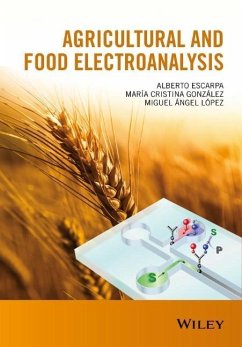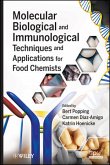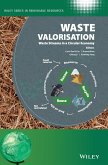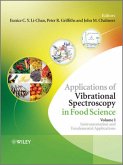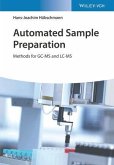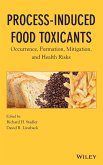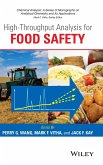- Gebundenes Buch
- Merkliste
- Auf die Merkliste
- Bewerten Bewerten
- Teilen
- Produkt teilen
- Produkterinnerung
- Produkterinnerung
Agricultural and Food Electroanalysis offers a comprehensive rationale of electroanalysis, revealing its enormous potential in agricultural food analysis. A unique approach is used which fills a gap in the literature by bringing in applications to everyday problems.
This timely text presents in-depth descriptions about different electrochemical techniques following their basic principles, instrumentation and main applications. Such techniques offer invaluable features such as inherent miniaturization, high sensitivity and selectivity, low cost, independence of sample turbidity, high…mehr
Andere Kunden interessierten sich auch für
![Molecular Biological and Immunological Techniques and Applications for Food Chemists Molecular Biological and Immunological Techniques and Applications for Food Chemists]() Molecular Biological and Immunological Techniques and Applications for Food Chemists197,99 €
Molecular Biological and Immunological Techniques and Applications for Food Chemists197,99 €![Waste Valorisation Waste Valorisation]() Waste Valorisation162,99 €
Waste Valorisation162,99 €![Applications of Vibrational Spectroscopy in Food Science, 2 Volume Set Applications of Vibrational Spectroscopy in Food Science, 2 Volume Set]() Applications of Vibrational Spectroscopy in Food Science, 2 Volume Set521,99 €
Applications of Vibrational Spectroscopy in Food Science, 2 Volume Set521,99 €![Mass Spectrometry in Grape and Wine Chemistry Mass Spectrometry in Grape and Wine Chemistry]() Riccardo FlaminiMass Spectrometry in Grape and Wine Chemistry158,99 €
Riccardo FlaminiMass Spectrometry in Grape and Wine Chemistry158,99 €![Automated Sample Preparation Automated Sample Preparation]() Hans-Joachim HübschmannAutomated Sample Preparation112,99 €
Hans-Joachim HübschmannAutomated Sample Preparation112,99 €![Process-Induced Food Toxicants Process-Induced Food Toxicants]() Process-Induced Food Toxicants234,99 €
Process-Induced Food Toxicants234,99 €![High-Throughput Analysis for Food Safety High-Throughput Analysis for Food Safety]() High-Throughput Analysis for Food Safety152,99 €
High-Throughput Analysis for Food Safety152,99 €-
-
-
Agricultural and Food Electroanalysis offers a comprehensive rationale of electroanalysis, revealing its enormous potential in agricultural food analysis. A unique approach is used which fills a gap in the literature by bringing in applications to everyday problems.
This timely text presents in-depth descriptions about different electrochemical techniques following their basic principles, instrumentation and main applications. Such techniques offer invaluable features such as inherent miniaturization, high sensitivity and selectivity, low cost, independence of sample turbidity, high compatibility with modern technologies such as microchips and biosensors, and the use of exciting nanomaterials such as nanoparticles, nanotubes and nanowires.
Due to the advantages that modern electroanalytical techniques bring to food analysis, and the huge importance and emphasis given today to food quality and safety, this comprehensive work will be an essential read for professionals and researchers working in analytical laboratories and development departments, and a valuable guide for students studying for careers in food science, technology and chemistry.
Hinweis: Dieser Artikel kann nur an eine deutsche Lieferadresse ausgeliefert werden.
This timely text presents in-depth descriptions about different electrochemical techniques following their basic principles, instrumentation and main applications. Such techniques offer invaluable features such as inherent miniaturization, high sensitivity and selectivity, low cost, independence of sample turbidity, high compatibility with modern technologies such as microchips and biosensors, and the use of exciting nanomaterials such as nanoparticles, nanotubes and nanowires.
Due to the advantages that modern electroanalytical techniques bring to food analysis, and the huge importance and emphasis given today to food quality and safety, this comprehensive work will be an essential read for professionals and researchers working in analytical laboratories and development departments, and a valuable guide for students studying for careers in food science, technology and chemistry.
Hinweis: Dieser Artikel kann nur an eine deutsche Lieferadresse ausgeliefert werden.
Produktdetails
- Produktdetails
- Verlag: Wiley & Sons / Wiley-Blackwell
- 1. Auflage
- Seitenzahl: 512
- Erscheinungstermin: 28. September 2015
- Englisch
- Abmessung: 246mm x 170mm x 28mm
- Gewicht: 1134g
- ISBN-13: 9781119961864
- ISBN-10: 1119961866
- Artikelnr.: 41748831
- Herstellerkennzeichnung
- Libri GmbH
- Europaallee 1
- 36244 Bad Hersfeld
- gpsr@libri.de
- Verlag: Wiley & Sons / Wiley-Blackwell
- 1. Auflage
- Seitenzahl: 512
- Erscheinungstermin: 28. September 2015
- Englisch
- Abmessung: 246mm x 170mm x 28mm
- Gewicht: 1134g
- ISBN-13: 9781119961864
- ISBN-10: 1119961866
- Artikelnr.: 41748831
- Herstellerkennzeichnung
- Libri GmbH
- Europaallee 1
- 36244 Bad Hersfeld
- gpsr@libri.de
ALBERTO ESCARPA Analytical Chemistry, Physical Chemistry and Chemical Engineering Department, University of Alcala, Spain MARÍA CRISTINA GONZÁLEZ Analytical Chemistry, Physical Chemistry and Chemical Engineering Department, University of Alcala, Spain MIGUEL ÁNGEL LÓPEZ Analytical Chemistry, Physical Chemistry and Chemical Engineering Department, University of Alcala, Spain
List of Contributors xv Preface xix 1. Electroanalysis and Food Analysis 1 Paloma Yá
nez-Sede
no and José M. Pingarrón 1.1 Introduction and Adequacy of Electroanalysis for Food Analysis 1 1.2 Methodologies Related to Measurement Techniques 2 1.2.1 Continuous Detection Methods 2 1.2.2 Stripping Analysis 5 1.2.3 Potentiometry and Chronopotentiometry 7 1.2.4 Electronic Tongues 7 1.2.5 Impedance Spectroscopy 9 1.3 Electrochemical Sensors and Biosensors for Food Components 9 1.3.1 Molecularly Imprinted Electrodes 9 1.3.2 Enzyme Biosensors 10 1.3.3 Affinity Biosensors 12 1.4 Nanomaterials for Electrochemical Analysis of Food 14 1.5 Future Trends 16 Acknowledgments 16 References 16 Part I Electroanalytical Techniques in Batch and Continuous Systems in Food Analysis 21 2. Voltammetric Techniques 23 Sandra Mendoza, Erika Bustos, Juan Manr
ýquez and Luis A. God
ýnez 2.1 Introduction 23 2.2 An Overview of Sweep Potential Electrochemical Techniques 23 2.2.1 Linear Sweep Voltammetry/Cyclic Voltammetry 25 2.2.2 Pulse Voltammetry Techniques 27 2.2.3 Normal Pulse Voltammetry 27 2.2.4 Differential Pulse Voltammetry 28 2.2.5 Square Wave Voltammetry 28 2.2.6 Stripping Voltammetry 29 2.3 Applications of Voltammetric Techniques in Food Analysis 31 2.3.1 Food Contaminants: Heavy Metals, Pesticides, and Toxic Substances 31 2.3.2 Trace Essential Elements 35 2.3.3 Food Additives 35 2.3.4 Nutraceuticals: Phenolic Acids, Flavonoids, and Others 40 2.4 Concluding Remarks 44 Abbreviations 44 References 44 3. Flow-Injection Analysis with Electrochemical Detection 49 Fabiana Silva Felix and Lúcio Angnes 3.1 Introduction 49 3.2 Screening the Literature 51 3.3 Voltammetry under Flowing Stream 52 3.4 Flow Injection Analysis Principles 52 3.4.1 Liquid Propulsion in FIA 54 3.4.2 Methods of Sample Introduction in an FIA System 56 3.4.3 Flow Cell Designs 57 3.5 Batch Injection Analysis Principles 58 3.6 Sequential Injection Analysis Principles 60 3.7 Applications 61 3.7.1 FIA and Voltammetric Detection-A Happy Marriage 61 3.7.2 BIA with Voltammetric Detection 64 3.7.3 SIA with Voltammetric Detection 65 3.8 Advantages of Voltammetry under Flowing Stream 66 3.9 Concluding Remarks 67 Acknowledgments 67 References 67 4. HPLC Techniques with Electrochemical Detection 73 Manuel Chicharro Santamar
ýa, Mónica Moreno Barambio and Alberto Sánchez Arribas 4.1 Introduction 73 4.2 Fundamentals 75 4.2.1 Electrochemical Cell 75 4.2.1.1 Electrode Materials 76 4.2.1.2 Flow-Cell Designs 77 4.2.1.3 Operation Modes 80 4.2.2 Development of HPLC-ED Methods 85 4.2.2.1 Getting Started 86 4.2.2.2 Hydrodynamic Voltammograms 86 4.2.2.3 Mobile Phase Composition 87 4.2.2.4 Temperature 89 4.2.2.5 Flow Rate 90 4.2.2.6 Electrode Treatment 90 4.2.2.7 Gradient Elution 91 4.2.2.8 Maintenance of HPLC-ED Systems 91 4.3 Analytical Designs and Performance 92 4.3.1 Natural Constituents 92 4.3.1.1 Carbohydrates 92 4.3.1.2 Amino Acids 94 4.3.1.3 Vitamins 96 4.3.1.4 Natural Phenolic Compounds 97 4.3.2 Nonanthropogenic Contaminants 98 4.3.2.1 Biogenic Amines 98 4.3.2.2 Mycotoxins 100 4.3.3 Anthropogenic Contaminants 101 4.3.3.1 Antibiotics 101 4.3.3.2 Pesticides (Herbicides, Insecticides, and Fungicides) 102 4.4 Concluding Remarks 104 References 105 5. Capillary Electrophoresis with Electrochemical Detection 117 Gang Chen 5.1 Introduction 117 5.2 Separation Techniques in Agricultural and Food Analysis 118 5.3 ECD in the CE Analysis of Foods and Agricultural Products 119 5.3.1 Amperometric Detection 119 5.3.2 Conductivity Detection and Potentiometric Detection 120 5.4 Instrumentations of CE-ECD 121 5.5 Determination of Nutritions by CE-ECD 122 5.5.1 Amino Acids and Peptides 122 5.5.2 Carbohydrates 124 5.5.3 Vitamins 126 5.5.4 Ions 127 5.6 Determination of Phenolic Compounds by CE-ECD 127 5.6.1 Phenols in Tea 127 5.6.2 Phenols in Coffee 127 5.6.3 Phenols in Wines 127 5.6.4 Phenols in Herbal Drugs 128 5.6.5 Flavones in Herbal Drugs 128 5.7 Determination of Purines by CE-ECD 130 5.8 Determination of Food Additives by CE-ECD 130 5.8.1 Preservatives 130 5.8.2 Antioxidants 131 5.8.3 Colors 131 5.8.4 Artificial Sweeteners 131 5.9 Summary 131 Abbreviations 132 Acknowledgments 132 References 133 Part II Electrochemical Sensing in Food Analysis 137 6. Microelectrode Designs 139 Jonathan P. Metters and Craig E. Banks 6.1 Introduction 139 6.2 Microfabrication Techniques 142 6.2.1 Lithography and Related Processes (Deposition, Sputtering, Other Relevant Technologies) 142 6.3 Screen-Printing for Producing Electrochemical Sensors 149 6.3.1 Improving Mass Transport 151 6.3.2 Metal Oxide Electrodes, Metal and Nano and Micro Modified Screen-Printed Sensors 159 6.4 Conclusions and Perspectives 161 References 161 7. Potentiometric Sensors 169 Geza Nagy and L
ývia Nagy 7.1 Introduction 169 7.2 The Types of Potentiometry 169 7.2.1 Potentiometric Stripping Analysis 170 7.2.2 Zero Current Potentiometry 171 7.2.3 Direct Potentiometry 175 7.2.4 Titrimetric Methods 177 7.3 The Selectivity of Ion-selective Electrodes and Its Determination 178 7.3.1 The Selectivity Coefficient 178 7.3.2 Separate Solution and Mixed Solution Methods 178 7.3.2.1 Separation Solution Methods 179 7.3.2.2 Mixed Solution Methods 180 7.4 Measuring Electrodes Used in Potentiometric Analysis 181 7.4.1 Ion-selective Field Effect Transistors 183 7.4.2 Severinghaus-type Probes 183 7.4.3 Potentiometric Enzyme Electrodes 184 7.5 Special Tasks 185 7.5.1 pH Measurements 185 7.5.2 Miscellaneous Analytical Tasks by Potentiometric Methods 190 7.6 Application of Potentiometric Measurements for Anions 191 7.6.1 Determination of Chloride Ion Concentration 191 7.6.1.1 Measurement of Cl
Concentration in Milk 192 7.6.1.2 Measurement of Cl
Concentration in Meat and Meat Products 192 7.6.1.3 Measurement of Cl
Concentration in Butter 192 7.6.1.4 Measurement of Cl
Concentration in Mayonnaise 192 7.6.1.5 Measurement of Cl
Concentration in Soil Samples 192 7.6.1.6 Chloride Ion Determination in Fruit Juice 193 7.6.2 Determination of Fluoride Ion Concentration 193 7.6.2.1 Fluoride Content of Wines 194 7.6.3 Applications of EPA Methods for Anion and Cation Analysis 194 7.6.4 Determination of Potassium Ion Concentration 195 7.6.5 Determination of Nitrate Ion Concentration 195 7.6.5.1 Nitrate Contain of Vegetables 195 7.6.6 Determination of Calcium Ion Concentration 197 7.6.7 Determination of Sweetening Additive Concentration 197 7.6.8 Determination of Fumaric Acid Concentration 197 7.6.8.1 Measuring the Fumarate Content in Gelatin 197 7.6.9 Quantification of Food Preservatives 198 7.6.9.1 Quantification of Sorbate 198 7.6.9.2 Quantification of Benzoate 198 7.6.10 Determination of Aluminum Ion Concentration 199 7.6.11 Methods for Detecting Histamine 199 References 200 8. Electrochemical Enzyme Biosensors 207 Ilaria Palchetti and Marco Mascini 8.1 Introduction 207 8.2 General Features of Enzyme Biosensors 209 8.2.1 Enzyme Biosensor Assembly 212 8.2.2 Enzyme Biosensor Stability 213 8.2.3 Biosensors Based on the Principle of Enzyme Inhibition 213 8.3 Analytical Features of Enzyme Based Biosensors 214 8.3.1 Biosensor Calibration 214 8.3.2 Biosensor Calibration for Determination of Inhibitors 215 8.3.3 Practical Aspects 215 8.3.3.1 Response Time 215 8.3.3.2 Thickness of the Enzyme Layer 216 8.3.3.3 Effect of Additional Membranes 216 8.4 Examples of Electrochemical Enzymatic Biosensors for Food Analysis 216 8.4.1 Detection of Pesticides 217 8.5 Conclusion 219 References 220 9. Electrochemical Immunosensors 223 M. Teresa Fernández-Abedul, M. Begöna González-Garc
ýa and Agust
ýn Costa-Garc
ýa 9.1 Introduction 223 9.2 Defining the Problem: The Targets 225 9.3 Recognizing the Target 231 9.3.1 Antibodies 231 9.3.2 Antigens 236 9.4 Immunosensing Architectures 236 9.4.1 Components of the Sensing Layer 238 9.4.2 Surface Engineering Procedures 256 9.4.3 Renewable Solid Surfaces 259 9.5 Performing Affinity Interactions for Molecular Recognition 260 9.6 Transducing Immunological Events 263 9.6.1 Electrode Materials and Types 263 9.6.1.1 Film Electrodes 264 9.6.2 Electrochemical Detection Methodologies 266 9.6.2.1 Label-Free Approaches 267 9.6.2.2 Amperometric Response to Labels 270 9.7 Advancing in Real Immunosensing 274 9.7.1 Multiplexed Determinations 275 9.7.2 Automation of Immunosensors 277 9.8 Processing Data 278 9.9 Conclusions 278 Abbreviations 280 References 283 10. Electrochemical Genosensors 295 Briza Pérez-López and Arben Merkoçi 10.1 General Introduction on Electrochemical Genosensors 295 10.1.1 Operation Principles 296 10.1.1.1 Label-Free (Direct) Detection 296 10.1.1.2 Label-Based (Indirect) Detection 300 10.2 Detection Methodologies 302 10.2.1 Voltammetric/Stripping 303 10.2.2 Potentiometric 304 10.2.3 Impedimetric 306 10.2.4 Conductometric 306 10.3 Applications 307 10.3.1 Species Identification 307 10.3.2 Contaminant Monitoring 309 10.4 Conclusions and Future Trends 311 Acknowledgments 311 References 311 11. Electrochemical Biosensors Based on Nanomaterials 317 Joseph Wang 11.1 Why Nanoscale Materials? 317 11.2 Nanowires, Nanotubes, and Nanoparticles 317 11.3 Nanomaterial-based Electrochemical Biosensors 319 11.3.1 Nanomaterial-based Biocatalytic Sensors 319 11.3.2 Nanomaterial-based Bioaffinity Sensors 321 11.4 Future Prospects 325 References 326 12. Electrochemical Sensing on Microfluidic Chips 331 Alberto Escarpa, Mar
ýa Cristina González and Miguel A. López 12.1 Electrochemical Detection Implementation in Microfluidic Chips 331 12.2 Microchip Electrophoresis with Electrochemical Detection for Food Analysis 335 12.2.1 Microchip Electrophoresis with Amperometric Detection for Organic Food Analytes 335 12.2.2 Microchip Electrophoresis with Amperometric Detection for Inorganic Food Analytes 341 12.2.3 Microchip Electrophoresis with Conductometric Detection for Food Analysis 341 12.3 Microfluidic Chips with Nanomaterial-Based Electrochemical Detection for Food Analysis 342 12.4 Microfluidic Electrochemical Biosensing Chips for Food Analysis 346 12.5 Outlook 350 Acknowledgments 351 Acronyms 351 References 352 13. Nanoelectrochemistry Applications Based on Electrospinning 357 Matteo Scampicchio, Maria Stella Cosio, Solomon Lemma Mengistu and Saverio Mannino 13.1 A Note on Nanoelectrochemistry 357 13.2 Electrochemical Sensors Modified with Nanofibrous Membranes 358 13.3 Introduction to Electrospinning 359 13.4 Applications of Electrochemical Sensors Based on Electrospinning 361 13.4.1 Nanofibrous Membranes as Coating Material 361 13.4.2 High Permeability 362 13.4.3 Selective Barrier to Diffusion 362 13.4.4 Conducting Nanofibrous Membranes 364 13.4.5 Biosensor Based on Nanofibrous Membranes 369 References 374 14. Electrochemical Impedance Spectroscopy 381 Araceli González-Cortés 14.1 Introduction 381 14.2 Impedance Spectroscopy-Theoretical Background 382 14.3 Chemical Sensors 387 14.4 Electrochemical Biosensors Based on Impedance Spectroscopy 390 14.4.1 Enzymatic Biosensors 391 14.4.2 Immunosensors 392 14.4.2.1 Impedimetric Immunosensors Using Interdigitated Array Microelectrodes 403 14.4.3 Genosensors and Aptasensors 406 14.5 Nonelectrochemical Interfacial Impedance 410 14.6 Conclusions and Perspectives 414 References 415 Part III Industrial Implications 421 15. Electroanalysis in Food Process Control 423 Maria Stella Cosio, Simona Benedetti, Matteo Scampicchio and Saverio Mannino 15.1 Sensors in Food Process 426 15.2 Electronic Nose 429 15.3 Electronic Nose Technologies 430 15.3.0.1 Metal Oxide Semiconductors 431 15.3.0.2 Metal Oxide Semiconductor Field-Effect Transistors 431 15.3.0.3 Conducting Organic Polymers 431 15.3.0.4 Piezoelectric Crystal Sensors 432 15.4 Electronic Noses for the Food Industry 433 15.5 Electronic Tongue 434 15.6 Pattern Recognition Models 436 15.7 Sampling 437 15.8 Conclusions 439 References 439 16. Instrumental Aspects of Food Analysis by Electrochemical Methods 443 Wendell K. T. Coltro, Maria F. Mora and Carlos D. Garcia 16.1 Introduction 443 16.2 Principles 444 16.3 Instrumentation for Electrochemical Detection 445 16.3.1 Instruments for Voltammetric Techniques 445 16.3.1.1 Amperometry 445 16.3.1.2 Pulsed Amperometric Detection 446 16.3.1.3 Voltammetry 447 16.3.2 Instrumentation for Potentiometric Techniques 448 16.3.3 Instruments for Conductometric Techniques 449 16.3.4 Instruments Developed for Portability 451 16.3.5 Low-Cost Potentiostats 455 16.3.6 Remotely Controlled Instruments 459 16.3.7 Electrochemical Detectors Coupled to Microchip Capillary Electrophoresis 460 16.4 Conclusions 464 Acknowledgments 464 References 464 Index 479
nez-Sede
no and José M. Pingarrón 1.1 Introduction and Adequacy of Electroanalysis for Food Analysis 1 1.2 Methodologies Related to Measurement Techniques 2 1.2.1 Continuous Detection Methods 2 1.2.2 Stripping Analysis 5 1.2.3 Potentiometry and Chronopotentiometry 7 1.2.4 Electronic Tongues 7 1.2.5 Impedance Spectroscopy 9 1.3 Electrochemical Sensors and Biosensors for Food Components 9 1.3.1 Molecularly Imprinted Electrodes 9 1.3.2 Enzyme Biosensors 10 1.3.3 Affinity Biosensors 12 1.4 Nanomaterials for Electrochemical Analysis of Food 14 1.5 Future Trends 16 Acknowledgments 16 References 16 Part I Electroanalytical Techniques in Batch and Continuous Systems in Food Analysis 21 2. Voltammetric Techniques 23 Sandra Mendoza, Erika Bustos, Juan Manr
ýquez and Luis A. God
ýnez 2.1 Introduction 23 2.2 An Overview of Sweep Potential Electrochemical Techniques 23 2.2.1 Linear Sweep Voltammetry/Cyclic Voltammetry 25 2.2.2 Pulse Voltammetry Techniques 27 2.2.3 Normal Pulse Voltammetry 27 2.2.4 Differential Pulse Voltammetry 28 2.2.5 Square Wave Voltammetry 28 2.2.6 Stripping Voltammetry 29 2.3 Applications of Voltammetric Techniques in Food Analysis 31 2.3.1 Food Contaminants: Heavy Metals, Pesticides, and Toxic Substances 31 2.3.2 Trace Essential Elements 35 2.3.3 Food Additives 35 2.3.4 Nutraceuticals: Phenolic Acids, Flavonoids, and Others 40 2.4 Concluding Remarks 44 Abbreviations 44 References 44 3. Flow-Injection Analysis with Electrochemical Detection 49 Fabiana Silva Felix and Lúcio Angnes 3.1 Introduction 49 3.2 Screening the Literature 51 3.3 Voltammetry under Flowing Stream 52 3.4 Flow Injection Analysis Principles 52 3.4.1 Liquid Propulsion in FIA 54 3.4.2 Methods of Sample Introduction in an FIA System 56 3.4.3 Flow Cell Designs 57 3.5 Batch Injection Analysis Principles 58 3.6 Sequential Injection Analysis Principles 60 3.7 Applications 61 3.7.1 FIA and Voltammetric Detection-A Happy Marriage 61 3.7.2 BIA with Voltammetric Detection 64 3.7.3 SIA with Voltammetric Detection 65 3.8 Advantages of Voltammetry under Flowing Stream 66 3.9 Concluding Remarks 67 Acknowledgments 67 References 67 4. HPLC Techniques with Electrochemical Detection 73 Manuel Chicharro Santamar
ýa, Mónica Moreno Barambio and Alberto Sánchez Arribas 4.1 Introduction 73 4.2 Fundamentals 75 4.2.1 Electrochemical Cell 75 4.2.1.1 Electrode Materials 76 4.2.1.2 Flow-Cell Designs 77 4.2.1.3 Operation Modes 80 4.2.2 Development of HPLC-ED Methods 85 4.2.2.1 Getting Started 86 4.2.2.2 Hydrodynamic Voltammograms 86 4.2.2.3 Mobile Phase Composition 87 4.2.2.4 Temperature 89 4.2.2.5 Flow Rate 90 4.2.2.6 Electrode Treatment 90 4.2.2.7 Gradient Elution 91 4.2.2.8 Maintenance of HPLC-ED Systems 91 4.3 Analytical Designs and Performance 92 4.3.1 Natural Constituents 92 4.3.1.1 Carbohydrates 92 4.3.1.2 Amino Acids 94 4.3.1.3 Vitamins 96 4.3.1.4 Natural Phenolic Compounds 97 4.3.2 Nonanthropogenic Contaminants 98 4.3.2.1 Biogenic Amines 98 4.3.2.2 Mycotoxins 100 4.3.3 Anthropogenic Contaminants 101 4.3.3.1 Antibiotics 101 4.3.3.2 Pesticides (Herbicides, Insecticides, and Fungicides) 102 4.4 Concluding Remarks 104 References 105 5. Capillary Electrophoresis with Electrochemical Detection 117 Gang Chen 5.1 Introduction 117 5.2 Separation Techniques in Agricultural and Food Analysis 118 5.3 ECD in the CE Analysis of Foods and Agricultural Products 119 5.3.1 Amperometric Detection 119 5.3.2 Conductivity Detection and Potentiometric Detection 120 5.4 Instrumentations of CE-ECD 121 5.5 Determination of Nutritions by CE-ECD 122 5.5.1 Amino Acids and Peptides 122 5.5.2 Carbohydrates 124 5.5.3 Vitamins 126 5.5.4 Ions 127 5.6 Determination of Phenolic Compounds by CE-ECD 127 5.6.1 Phenols in Tea 127 5.6.2 Phenols in Coffee 127 5.6.3 Phenols in Wines 127 5.6.4 Phenols in Herbal Drugs 128 5.6.5 Flavones in Herbal Drugs 128 5.7 Determination of Purines by CE-ECD 130 5.8 Determination of Food Additives by CE-ECD 130 5.8.1 Preservatives 130 5.8.2 Antioxidants 131 5.8.3 Colors 131 5.8.4 Artificial Sweeteners 131 5.9 Summary 131 Abbreviations 132 Acknowledgments 132 References 133 Part II Electrochemical Sensing in Food Analysis 137 6. Microelectrode Designs 139 Jonathan P. Metters and Craig E. Banks 6.1 Introduction 139 6.2 Microfabrication Techniques 142 6.2.1 Lithography and Related Processes (Deposition, Sputtering, Other Relevant Technologies) 142 6.3 Screen-Printing for Producing Electrochemical Sensors 149 6.3.1 Improving Mass Transport 151 6.3.2 Metal Oxide Electrodes, Metal and Nano and Micro Modified Screen-Printed Sensors 159 6.4 Conclusions and Perspectives 161 References 161 7. Potentiometric Sensors 169 Geza Nagy and L
ývia Nagy 7.1 Introduction 169 7.2 The Types of Potentiometry 169 7.2.1 Potentiometric Stripping Analysis 170 7.2.2 Zero Current Potentiometry 171 7.2.3 Direct Potentiometry 175 7.2.4 Titrimetric Methods 177 7.3 The Selectivity of Ion-selective Electrodes and Its Determination 178 7.3.1 The Selectivity Coefficient 178 7.3.2 Separate Solution and Mixed Solution Methods 178 7.3.2.1 Separation Solution Methods 179 7.3.2.2 Mixed Solution Methods 180 7.4 Measuring Electrodes Used in Potentiometric Analysis 181 7.4.1 Ion-selective Field Effect Transistors 183 7.4.2 Severinghaus-type Probes 183 7.4.3 Potentiometric Enzyme Electrodes 184 7.5 Special Tasks 185 7.5.1 pH Measurements 185 7.5.2 Miscellaneous Analytical Tasks by Potentiometric Methods 190 7.6 Application of Potentiometric Measurements for Anions 191 7.6.1 Determination of Chloride Ion Concentration 191 7.6.1.1 Measurement of Cl
Concentration in Milk 192 7.6.1.2 Measurement of Cl
Concentration in Meat and Meat Products 192 7.6.1.3 Measurement of Cl
Concentration in Butter 192 7.6.1.4 Measurement of Cl
Concentration in Mayonnaise 192 7.6.1.5 Measurement of Cl
Concentration in Soil Samples 192 7.6.1.6 Chloride Ion Determination in Fruit Juice 193 7.6.2 Determination of Fluoride Ion Concentration 193 7.6.2.1 Fluoride Content of Wines 194 7.6.3 Applications of EPA Methods for Anion and Cation Analysis 194 7.6.4 Determination of Potassium Ion Concentration 195 7.6.5 Determination of Nitrate Ion Concentration 195 7.6.5.1 Nitrate Contain of Vegetables 195 7.6.6 Determination of Calcium Ion Concentration 197 7.6.7 Determination of Sweetening Additive Concentration 197 7.6.8 Determination of Fumaric Acid Concentration 197 7.6.8.1 Measuring the Fumarate Content in Gelatin 197 7.6.9 Quantification of Food Preservatives 198 7.6.9.1 Quantification of Sorbate 198 7.6.9.2 Quantification of Benzoate 198 7.6.10 Determination of Aluminum Ion Concentration 199 7.6.11 Methods for Detecting Histamine 199 References 200 8. Electrochemical Enzyme Biosensors 207 Ilaria Palchetti and Marco Mascini 8.1 Introduction 207 8.2 General Features of Enzyme Biosensors 209 8.2.1 Enzyme Biosensor Assembly 212 8.2.2 Enzyme Biosensor Stability 213 8.2.3 Biosensors Based on the Principle of Enzyme Inhibition 213 8.3 Analytical Features of Enzyme Based Biosensors 214 8.3.1 Biosensor Calibration 214 8.3.2 Biosensor Calibration for Determination of Inhibitors 215 8.3.3 Practical Aspects 215 8.3.3.1 Response Time 215 8.3.3.2 Thickness of the Enzyme Layer 216 8.3.3.3 Effect of Additional Membranes 216 8.4 Examples of Electrochemical Enzymatic Biosensors for Food Analysis 216 8.4.1 Detection of Pesticides 217 8.5 Conclusion 219 References 220 9. Electrochemical Immunosensors 223 M. Teresa Fernández-Abedul, M. Begöna González-Garc
ýa and Agust
ýn Costa-Garc
ýa 9.1 Introduction 223 9.2 Defining the Problem: The Targets 225 9.3 Recognizing the Target 231 9.3.1 Antibodies 231 9.3.2 Antigens 236 9.4 Immunosensing Architectures 236 9.4.1 Components of the Sensing Layer 238 9.4.2 Surface Engineering Procedures 256 9.4.3 Renewable Solid Surfaces 259 9.5 Performing Affinity Interactions for Molecular Recognition 260 9.6 Transducing Immunological Events 263 9.6.1 Electrode Materials and Types 263 9.6.1.1 Film Electrodes 264 9.6.2 Electrochemical Detection Methodologies 266 9.6.2.1 Label-Free Approaches 267 9.6.2.2 Amperometric Response to Labels 270 9.7 Advancing in Real Immunosensing 274 9.7.1 Multiplexed Determinations 275 9.7.2 Automation of Immunosensors 277 9.8 Processing Data 278 9.9 Conclusions 278 Abbreviations 280 References 283 10. Electrochemical Genosensors 295 Briza Pérez-López and Arben Merkoçi 10.1 General Introduction on Electrochemical Genosensors 295 10.1.1 Operation Principles 296 10.1.1.1 Label-Free (Direct) Detection 296 10.1.1.2 Label-Based (Indirect) Detection 300 10.2 Detection Methodologies 302 10.2.1 Voltammetric/Stripping 303 10.2.2 Potentiometric 304 10.2.3 Impedimetric 306 10.2.4 Conductometric 306 10.3 Applications 307 10.3.1 Species Identification 307 10.3.2 Contaminant Monitoring 309 10.4 Conclusions and Future Trends 311 Acknowledgments 311 References 311 11. Electrochemical Biosensors Based on Nanomaterials 317 Joseph Wang 11.1 Why Nanoscale Materials? 317 11.2 Nanowires, Nanotubes, and Nanoparticles 317 11.3 Nanomaterial-based Electrochemical Biosensors 319 11.3.1 Nanomaterial-based Biocatalytic Sensors 319 11.3.2 Nanomaterial-based Bioaffinity Sensors 321 11.4 Future Prospects 325 References 326 12. Electrochemical Sensing on Microfluidic Chips 331 Alberto Escarpa, Mar
ýa Cristina González and Miguel A. López 12.1 Electrochemical Detection Implementation in Microfluidic Chips 331 12.2 Microchip Electrophoresis with Electrochemical Detection for Food Analysis 335 12.2.1 Microchip Electrophoresis with Amperometric Detection for Organic Food Analytes 335 12.2.2 Microchip Electrophoresis with Amperometric Detection for Inorganic Food Analytes 341 12.2.3 Microchip Electrophoresis with Conductometric Detection for Food Analysis 341 12.3 Microfluidic Chips with Nanomaterial-Based Electrochemical Detection for Food Analysis 342 12.4 Microfluidic Electrochemical Biosensing Chips for Food Analysis 346 12.5 Outlook 350 Acknowledgments 351 Acronyms 351 References 352 13. Nanoelectrochemistry Applications Based on Electrospinning 357 Matteo Scampicchio, Maria Stella Cosio, Solomon Lemma Mengistu and Saverio Mannino 13.1 A Note on Nanoelectrochemistry 357 13.2 Electrochemical Sensors Modified with Nanofibrous Membranes 358 13.3 Introduction to Electrospinning 359 13.4 Applications of Electrochemical Sensors Based on Electrospinning 361 13.4.1 Nanofibrous Membranes as Coating Material 361 13.4.2 High Permeability 362 13.4.3 Selective Barrier to Diffusion 362 13.4.4 Conducting Nanofibrous Membranes 364 13.4.5 Biosensor Based on Nanofibrous Membranes 369 References 374 14. Electrochemical Impedance Spectroscopy 381 Araceli González-Cortés 14.1 Introduction 381 14.2 Impedance Spectroscopy-Theoretical Background 382 14.3 Chemical Sensors 387 14.4 Electrochemical Biosensors Based on Impedance Spectroscopy 390 14.4.1 Enzymatic Biosensors 391 14.4.2 Immunosensors 392 14.4.2.1 Impedimetric Immunosensors Using Interdigitated Array Microelectrodes 403 14.4.3 Genosensors and Aptasensors 406 14.5 Nonelectrochemical Interfacial Impedance 410 14.6 Conclusions and Perspectives 414 References 415 Part III Industrial Implications 421 15. Electroanalysis in Food Process Control 423 Maria Stella Cosio, Simona Benedetti, Matteo Scampicchio and Saverio Mannino 15.1 Sensors in Food Process 426 15.2 Electronic Nose 429 15.3 Electronic Nose Technologies 430 15.3.0.1 Metal Oxide Semiconductors 431 15.3.0.2 Metal Oxide Semiconductor Field-Effect Transistors 431 15.3.0.3 Conducting Organic Polymers 431 15.3.0.4 Piezoelectric Crystal Sensors 432 15.4 Electronic Noses for the Food Industry 433 15.5 Electronic Tongue 434 15.6 Pattern Recognition Models 436 15.7 Sampling 437 15.8 Conclusions 439 References 439 16. Instrumental Aspects of Food Analysis by Electrochemical Methods 443 Wendell K. T. Coltro, Maria F. Mora and Carlos D. Garcia 16.1 Introduction 443 16.2 Principles 444 16.3 Instrumentation for Electrochemical Detection 445 16.3.1 Instruments for Voltammetric Techniques 445 16.3.1.1 Amperometry 445 16.3.1.2 Pulsed Amperometric Detection 446 16.3.1.3 Voltammetry 447 16.3.2 Instrumentation for Potentiometric Techniques 448 16.3.3 Instruments for Conductometric Techniques 449 16.3.4 Instruments Developed for Portability 451 16.3.5 Low-Cost Potentiostats 455 16.3.6 Remotely Controlled Instruments 459 16.3.7 Electrochemical Detectors Coupled to Microchip Capillary Electrophoresis 460 16.4 Conclusions 464 Acknowledgments 464 References 464 Index 479
List of Contributors xv Preface xix 1. Electroanalysis and Food Analysis 1 Paloma Yá
nez-Sede
no and José M. Pingarrón 1.1 Introduction and Adequacy of Electroanalysis for Food Analysis 1 1.2 Methodologies Related to Measurement Techniques 2 1.2.1 Continuous Detection Methods 2 1.2.2 Stripping Analysis 5 1.2.3 Potentiometry and Chronopotentiometry 7 1.2.4 Electronic Tongues 7 1.2.5 Impedance Spectroscopy 9 1.3 Electrochemical Sensors and Biosensors for Food Components 9 1.3.1 Molecularly Imprinted Electrodes 9 1.3.2 Enzyme Biosensors 10 1.3.3 Affinity Biosensors 12 1.4 Nanomaterials for Electrochemical Analysis of Food 14 1.5 Future Trends 16 Acknowledgments 16 References 16 Part I Electroanalytical Techniques in Batch and Continuous Systems in Food Analysis 21 2. Voltammetric Techniques 23 Sandra Mendoza, Erika Bustos, Juan Manr
ýquez and Luis A. God
ýnez 2.1 Introduction 23 2.2 An Overview of Sweep Potential Electrochemical Techniques 23 2.2.1 Linear Sweep Voltammetry/Cyclic Voltammetry 25 2.2.2 Pulse Voltammetry Techniques 27 2.2.3 Normal Pulse Voltammetry 27 2.2.4 Differential Pulse Voltammetry 28 2.2.5 Square Wave Voltammetry 28 2.2.6 Stripping Voltammetry 29 2.3 Applications of Voltammetric Techniques in Food Analysis 31 2.3.1 Food Contaminants: Heavy Metals, Pesticides, and Toxic Substances 31 2.3.2 Trace Essential Elements 35 2.3.3 Food Additives 35 2.3.4 Nutraceuticals: Phenolic Acids, Flavonoids, and Others 40 2.4 Concluding Remarks 44 Abbreviations 44 References 44 3. Flow-Injection Analysis with Electrochemical Detection 49 Fabiana Silva Felix and Lúcio Angnes 3.1 Introduction 49 3.2 Screening the Literature 51 3.3 Voltammetry under Flowing Stream 52 3.4 Flow Injection Analysis Principles 52 3.4.1 Liquid Propulsion in FIA 54 3.4.2 Methods of Sample Introduction in an FIA System 56 3.4.3 Flow Cell Designs 57 3.5 Batch Injection Analysis Principles 58 3.6 Sequential Injection Analysis Principles 60 3.7 Applications 61 3.7.1 FIA and Voltammetric Detection-A Happy Marriage 61 3.7.2 BIA with Voltammetric Detection 64 3.7.3 SIA with Voltammetric Detection 65 3.8 Advantages of Voltammetry under Flowing Stream 66 3.9 Concluding Remarks 67 Acknowledgments 67 References 67 4. HPLC Techniques with Electrochemical Detection 73 Manuel Chicharro Santamar
ýa, Mónica Moreno Barambio and Alberto Sánchez Arribas 4.1 Introduction 73 4.2 Fundamentals 75 4.2.1 Electrochemical Cell 75 4.2.1.1 Electrode Materials 76 4.2.1.2 Flow-Cell Designs 77 4.2.1.3 Operation Modes 80 4.2.2 Development of HPLC-ED Methods 85 4.2.2.1 Getting Started 86 4.2.2.2 Hydrodynamic Voltammograms 86 4.2.2.3 Mobile Phase Composition 87 4.2.2.4 Temperature 89 4.2.2.5 Flow Rate 90 4.2.2.6 Electrode Treatment 90 4.2.2.7 Gradient Elution 91 4.2.2.8 Maintenance of HPLC-ED Systems 91 4.3 Analytical Designs and Performance 92 4.3.1 Natural Constituents 92 4.3.1.1 Carbohydrates 92 4.3.1.2 Amino Acids 94 4.3.1.3 Vitamins 96 4.3.1.4 Natural Phenolic Compounds 97 4.3.2 Nonanthropogenic Contaminants 98 4.3.2.1 Biogenic Amines 98 4.3.2.2 Mycotoxins 100 4.3.3 Anthropogenic Contaminants 101 4.3.3.1 Antibiotics 101 4.3.3.2 Pesticides (Herbicides, Insecticides, and Fungicides) 102 4.4 Concluding Remarks 104 References 105 5. Capillary Electrophoresis with Electrochemical Detection 117 Gang Chen 5.1 Introduction 117 5.2 Separation Techniques in Agricultural and Food Analysis 118 5.3 ECD in the CE Analysis of Foods and Agricultural Products 119 5.3.1 Amperometric Detection 119 5.3.2 Conductivity Detection and Potentiometric Detection 120 5.4 Instrumentations of CE-ECD 121 5.5 Determination of Nutritions by CE-ECD 122 5.5.1 Amino Acids and Peptides 122 5.5.2 Carbohydrates 124 5.5.3 Vitamins 126 5.5.4 Ions 127 5.6 Determination of Phenolic Compounds by CE-ECD 127 5.6.1 Phenols in Tea 127 5.6.2 Phenols in Coffee 127 5.6.3 Phenols in Wines 127 5.6.4 Phenols in Herbal Drugs 128 5.6.5 Flavones in Herbal Drugs 128 5.7 Determination of Purines by CE-ECD 130 5.8 Determination of Food Additives by CE-ECD 130 5.8.1 Preservatives 130 5.8.2 Antioxidants 131 5.8.3 Colors 131 5.8.4 Artificial Sweeteners 131 5.9 Summary 131 Abbreviations 132 Acknowledgments 132 References 133 Part II Electrochemical Sensing in Food Analysis 137 6. Microelectrode Designs 139 Jonathan P. Metters and Craig E. Banks 6.1 Introduction 139 6.2 Microfabrication Techniques 142 6.2.1 Lithography and Related Processes (Deposition, Sputtering, Other Relevant Technologies) 142 6.3 Screen-Printing for Producing Electrochemical Sensors 149 6.3.1 Improving Mass Transport 151 6.3.2 Metal Oxide Electrodes, Metal and Nano and Micro Modified Screen-Printed Sensors 159 6.4 Conclusions and Perspectives 161 References 161 7. Potentiometric Sensors 169 Geza Nagy and L
ývia Nagy 7.1 Introduction 169 7.2 The Types of Potentiometry 169 7.2.1 Potentiometric Stripping Analysis 170 7.2.2 Zero Current Potentiometry 171 7.2.3 Direct Potentiometry 175 7.2.4 Titrimetric Methods 177 7.3 The Selectivity of Ion-selective Electrodes and Its Determination 178 7.3.1 The Selectivity Coefficient 178 7.3.2 Separate Solution and Mixed Solution Methods 178 7.3.2.1 Separation Solution Methods 179 7.3.2.2 Mixed Solution Methods 180 7.4 Measuring Electrodes Used in Potentiometric Analysis 181 7.4.1 Ion-selective Field Effect Transistors 183 7.4.2 Severinghaus-type Probes 183 7.4.3 Potentiometric Enzyme Electrodes 184 7.5 Special Tasks 185 7.5.1 pH Measurements 185 7.5.2 Miscellaneous Analytical Tasks by Potentiometric Methods 190 7.6 Application of Potentiometric Measurements for Anions 191 7.6.1 Determination of Chloride Ion Concentration 191 7.6.1.1 Measurement of Cl
Concentration in Milk 192 7.6.1.2 Measurement of Cl
Concentration in Meat and Meat Products 192 7.6.1.3 Measurement of Cl
Concentration in Butter 192 7.6.1.4 Measurement of Cl
Concentration in Mayonnaise 192 7.6.1.5 Measurement of Cl
Concentration in Soil Samples 192 7.6.1.6 Chloride Ion Determination in Fruit Juice 193 7.6.2 Determination of Fluoride Ion Concentration 193 7.6.2.1 Fluoride Content of Wines 194 7.6.3 Applications of EPA Methods for Anion and Cation Analysis 194 7.6.4 Determination of Potassium Ion Concentration 195 7.6.5 Determination of Nitrate Ion Concentration 195 7.6.5.1 Nitrate Contain of Vegetables 195 7.6.6 Determination of Calcium Ion Concentration 197 7.6.7 Determination of Sweetening Additive Concentration 197 7.6.8 Determination of Fumaric Acid Concentration 197 7.6.8.1 Measuring the Fumarate Content in Gelatin 197 7.6.9 Quantification of Food Preservatives 198 7.6.9.1 Quantification of Sorbate 198 7.6.9.2 Quantification of Benzoate 198 7.6.10 Determination of Aluminum Ion Concentration 199 7.6.11 Methods for Detecting Histamine 199 References 200 8. Electrochemical Enzyme Biosensors 207 Ilaria Palchetti and Marco Mascini 8.1 Introduction 207 8.2 General Features of Enzyme Biosensors 209 8.2.1 Enzyme Biosensor Assembly 212 8.2.2 Enzyme Biosensor Stability 213 8.2.3 Biosensors Based on the Principle of Enzyme Inhibition 213 8.3 Analytical Features of Enzyme Based Biosensors 214 8.3.1 Biosensor Calibration 214 8.3.2 Biosensor Calibration for Determination of Inhibitors 215 8.3.3 Practical Aspects 215 8.3.3.1 Response Time 215 8.3.3.2 Thickness of the Enzyme Layer 216 8.3.3.3 Effect of Additional Membranes 216 8.4 Examples of Electrochemical Enzymatic Biosensors for Food Analysis 216 8.4.1 Detection of Pesticides 217 8.5 Conclusion 219 References 220 9. Electrochemical Immunosensors 223 M. Teresa Fernández-Abedul, M. Begöna González-Garc
ýa and Agust
ýn Costa-Garc
ýa 9.1 Introduction 223 9.2 Defining the Problem: The Targets 225 9.3 Recognizing the Target 231 9.3.1 Antibodies 231 9.3.2 Antigens 236 9.4 Immunosensing Architectures 236 9.4.1 Components of the Sensing Layer 238 9.4.2 Surface Engineering Procedures 256 9.4.3 Renewable Solid Surfaces 259 9.5 Performing Affinity Interactions for Molecular Recognition 260 9.6 Transducing Immunological Events 263 9.6.1 Electrode Materials and Types 263 9.6.1.1 Film Electrodes 264 9.6.2 Electrochemical Detection Methodologies 266 9.6.2.1 Label-Free Approaches 267 9.6.2.2 Amperometric Response to Labels 270 9.7 Advancing in Real Immunosensing 274 9.7.1 Multiplexed Determinations 275 9.7.2 Automation of Immunosensors 277 9.8 Processing Data 278 9.9 Conclusions 278 Abbreviations 280 References 283 10. Electrochemical Genosensors 295 Briza Pérez-López and Arben Merkoçi 10.1 General Introduction on Electrochemical Genosensors 295 10.1.1 Operation Principles 296 10.1.1.1 Label-Free (Direct) Detection 296 10.1.1.2 Label-Based (Indirect) Detection 300 10.2 Detection Methodologies 302 10.2.1 Voltammetric/Stripping 303 10.2.2 Potentiometric 304 10.2.3 Impedimetric 306 10.2.4 Conductometric 306 10.3 Applications 307 10.3.1 Species Identification 307 10.3.2 Contaminant Monitoring 309 10.4 Conclusions and Future Trends 311 Acknowledgments 311 References 311 11. Electrochemical Biosensors Based on Nanomaterials 317 Joseph Wang 11.1 Why Nanoscale Materials? 317 11.2 Nanowires, Nanotubes, and Nanoparticles 317 11.3 Nanomaterial-based Electrochemical Biosensors 319 11.3.1 Nanomaterial-based Biocatalytic Sensors 319 11.3.2 Nanomaterial-based Bioaffinity Sensors 321 11.4 Future Prospects 325 References 326 12. Electrochemical Sensing on Microfluidic Chips 331 Alberto Escarpa, Mar
ýa Cristina González and Miguel A. López 12.1 Electrochemical Detection Implementation in Microfluidic Chips 331 12.2 Microchip Electrophoresis with Electrochemical Detection for Food Analysis 335 12.2.1 Microchip Electrophoresis with Amperometric Detection for Organic Food Analytes 335 12.2.2 Microchip Electrophoresis with Amperometric Detection for Inorganic Food Analytes 341 12.2.3 Microchip Electrophoresis with Conductometric Detection for Food Analysis 341 12.3 Microfluidic Chips with Nanomaterial-Based Electrochemical Detection for Food Analysis 342 12.4 Microfluidic Electrochemical Biosensing Chips for Food Analysis 346 12.5 Outlook 350 Acknowledgments 351 Acronyms 351 References 352 13. Nanoelectrochemistry Applications Based on Electrospinning 357 Matteo Scampicchio, Maria Stella Cosio, Solomon Lemma Mengistu and Saverio Mannino 13.1 A Note on Nanoelectrochemistry 357 13.2 Electrochemical Sensors Modified with Nanofibrous Membranes 358 13.3 Introduction to Electrospinning 359 13.4 Applications of Electrochemical Sensors Based on Electrospinning 361 13.4.1 Nanofibrous Membranes as Coating Material 361 13.4.2 High Permeability 362 13.4.3 Selective Barrier to Diffusion 362 13.4.4 Conducting Nanofibrous Membranes 364 13.4.5 Biosensor Based on Nanofibrous Membranes 369 References 374 14. Electrochemical Impedance Spectroscopy 381 Araceli González-Cortés 14.1 Introduction 381 14.2 Impedance Spectroscopy-Theoretical Background 382 14.3 Chemical Sensors 387 14.4 Electrochemical Biosensors Based on Impedance Spectroscopy 390 14.4.1 Enzymatic Biosensors 391 14.4.2 Immunosensors 392 14.4.2.1 Impedimetric Immunosensors Using Interdigitated Array Microelectrodes 403 14.4.3 Genosensors and Aptasensors 406 14.5 Nonelectrochemical Interfacial Impedance 410 14.6 Conclusions and Perspectives 414 References 415 Part III Industrial Implications 421 15. Electroanalysis in Food Process Control 423 Maria Stella Cosio, Simona Benedetti, Matteo Scampicchio and Saverio Mannino 15.1 Sensors in Food Process 426 15.2 Electronic Nose 429 15.3 Electronic Nose Technologies 430 15.3.0.1 Metal Oxide Semiconductors 431 15.3.0.2 Metal Oxide Semiconductor Field-Effect Transistors 431 15.3.0.3 Conducting Organic Polymers 431 15.3.0.4 Piezoelectric Crystal Sensors 432 15.4 Electronic Noses for the Food Industry 433 15.5 Electronic Tongue 434 15.6 Pattern Recognition Models 436 15.7 Sampling 437 15.8 Conclusions 439 References 439 16. Instrumental Aspects of Food Analysis by Electrochemical Methods 443 Wendell K. T. Coltro, Maria F. Mora and Carlos D. Garcia 16.1 Introduction 443 16.2 Principles 444 16.3 Instrumentation for Electrochemical Detection 445 16.3.1 Instruments for Voltammetric Techniques 445 16.3.1.1 Amperometry 445 16.3.1.2 Pulsed Amperometric Detection 446 16.3.1.3 Voltammetry 447 16.3.2 Instrumentation for Potentiometric Techniques 448 16.3.3 Instruments for Conductometric Techniques 449 16.3.4 Instruments Developed for Portability 451 16.3.5 Low-Cost Potentiostats 455 16.3.6 Remotely Controlled Instruments 459 16.3.7 Electrochemical Detectors Coupled to Microchip Capillary Electrophoresis 460 16.4 Conclusions 464 Acknowledgments 464 References 464 Index 479
nez-Sede
no and José M. Pingarrón 1.1 Introduction and Adequacy of Electroanalysis for Food Analysis 1 1.2 Methodologies Related to Measurement Techniques 2 1.2.1 Continuous Detection Methods 2 1.2.2 Stripping Analysis 5 1.2.3 Potentiometry and Chronopotentiometry 7 1.2.4 Electronic Tongues 7 1.2.5 Impedance Spectroscopy 9 1.3 Electrochemical Sensors and Biosensors for Food Components 9 1.3.1 Molecularly Imprinted Electrodes 9 1.3.2 Enzyme Biosensors 10 1.3.3 Affinity Biosensors 12 1.4 Nanomaterials for Electrochemical Analysis of Food 14 1.5 Future Trends 16 Acknowledgments 16 References 16 Part I Electroanalytical Techniques in Batch and Continuous Systems in Food Analysis 21 2. Voltammetric Techniques 23 Sandra Mendoza, Erika Bustos, Juan Manr
ýquez and Luis A. God
ýnez 2.1 Introduction 23 2.2 An Overview of Sweep Potential Electrochemical Techniques 23 2.2.1 Linear Sweep Voltammetry/Cyclic Voltammetry 25 2.2.2 Pulse Voltammetry Techniques 27 2.2.3 Normal Pulse Voltammetry 27 2.2.4 Differential Pulse Voltammetry 28 2.2.5 Square Wave Voltammetry 28 2.2.6 Stripping Voltammetry 29 2.3 Applications of Voltammetric Techniques in Food Analysis 31 2.3.1 Food Contaminants: Heavy Metals, Pesticides, and Toxic Substances 31 2.3.2 Trace Essential Elements 35 2.3.3 Food Additives 35 2.3.4 Nutraceuticals: Phenolic Acids, Flavonoids, and Others 40 2.4 Concluding Remarks 44 Abbreviations 44 References 44 3. Flow-Injection Analysis with Electrochemical Detection 49 Fabiana Silva Felix and Lúcio Angnes 3.1 Introduction 49 3.2 Screening the Literature 51 3.3 Voltammetry under Flowing Stream 52 3.4 Flow Injection Analysis Principles 52 3.4.1 Liquid Propulsion in FIA 54 3.4.2 Methods of Sample Introduction in an FIA System 56 3.4.3 Flow Cell Designs 57 3.5 Batch Injection Analysis Principles 58 3.6 Sequential Injection Analysis Principles 60 3.7 Applications 61 3.7.1 FIA and Voltammetric Detection-A Happy Marriage 61 3.7.2 BIA with Voltammetric Detection 64 3.7.3 SIA with Voltammetric Detection 65 3.8 Advantages of Voltammetry under Flowing Stream 66 3.9 Concluding Remarks 67 Acknowledgments 67 References 67 4. HPLC Techniques with Electrochemical Detection 73 Manuel Chicharro Santamar
ýa, Mónica Moreno Barambio and Alberto Sánchez Arribas 4.1 Introduction 73 4.2 Fundamentals 75 4.2.1 Electrochemical Cell 75 4.2.1.1 Electrode Materials 76 4.2.1.2 Flow-Cell Designs 77 4.2.1.3 Operation Modes 80 4.2.2 Development of HPLC-ED Methods 85 4.2.2.1 Getting Started 86 4.2.2.2 Hydrodynamic Voltammograms 86 4.2.2.3 Mobile Phase Composition 87 4.2.2.4 Temperature 89 4.2.2.5 Flow Rate 90 4.2.2.6 Electrode Treatment 90 4.2.2.7 Gradient Elution 91 4.2.2.8 Maintenance of HPLC-ED Systems 91 4.3 Analytical Designs and Performance 92 4.3.1 Natural Constituents 92 4.3.1.1 Carbohydrates 92 4.3.1.2 Amino Acids 94 4.3.1.3 Vitamins 96 4.3.1.4 Natural Phenolic Compounds 97 4.3.2 Nonanthropogenic Contaminants 98 4.3.2.1 Biogenic Amines 98 4.3.2.2 Mycotoxins 100 4.3.3 Anthropogenic Contaminants 101 4.3.3.1 Antibiotics 101 4.3.3.2 Pesticides (Herbicides, Insecticides, and Fungicides) 102 4.4 Concluding Remarks 104 References 105 5. Capillary Electrophoresis with Electrochemical Detection 117 Gang Chen 5.1 Introduction 117 5.2 Separation Techniques in Agricultural and Food Analysis 118 5.3 ECD in the CE Analysis of Foods and Agricultural Products 119 5.3.1 Amperometric Detection 119 5.3.2 Conductivity Detection and Potentiometric Detection 120 5.4 Instrumentations of CE-ECD 121 5.5 Determination of Nutritions by CE-ECD 122 5.5.1 Amino Acids and Peptides 122 5.5.2 Carbohydrates 124 5.5.3 Vitamins 126 5.5.4 Ions 127 5.6 Determination of Phenolic Compounds by CE-ECD 127 5.6.1 Phenols in Tea 127 5.6.2 Phenols in Coffee 127 5.6.3 Phenols in Wines 127 5.6.4 Phenols in Herbal Drugs 128 5.6.5 Flavones in Herbal Drugs 128 5.7 Determination of Purines by CE-ECD 130 5.8 Determination of Food Additives by CE-ECD 130 5.8.1 Preservatives 130 5.8.2 Antioxidants 131 5.8.3 Colors 131 5.8.4 Artificial Sweeteners 131 5.9 Summary 131 Abbreviations 132 Acknowledgments 132 References 133 Part II Electrochemical Sensing in Food Analysis 137 6. Microelectrode Designs 139 Jonathan P. Metters and Craig E. Banks 6.1 Introduction 139 6.2 Microfabrication Techniques 142 6.2.1 Lithography and Related Processes (Deposition, Sputtering, Other Relevant Technologies) 142 6.3 Screen-Printing for Producing Electrochemical Sensors 149 6.3.1 Improving Mass Transport 151 6.3.2 Metal Oxide Electrodes, Metal and Nano and Micro Modified Screen-Printed Sensors 159 6.4 Conclusions and Perspectives 161 References 161 7. Potentiometric Sensors 169 Geza Nagy and L
ývia Nagy 7.1 Introduction 169 7.2 The Types of Potentiometry 169 7.2.1 Potentiometric Stripping Analysis 170 7.2.2 Zero Current Potentiometry 171 7.2.3 Direct Potentiometry 175 7.2.4 Titrimetric Methods 177 7.3 The Selectivity of Ion-selective Electrodes and Its Determination 178 7.3.1 The Selectivity Coefficient 178 7.3.2 Separate Solution and Mixed Solution Methods 178 7.3.2.1 Separation Solution Methods 179 7.3.2.2 Mixed Solution Methods 180 7.4 Measuring Electrodes Used in Potentiometric Analysis 181 7.4.1 Ion-selective Field Effect Transistors 183 7.4.2 Severinghaus-type Probes 183 7.4.3 Potentiometric Enzyme Electrodes 184 7.5 Special Tasks 185 7.5.1 pH Measurements 185 7.5.2 Miscellaneous Analytical Tasks by Potentiometric Methods 190 7.6 Application of Potentiometric Measurements for Anions 191 7.6.1 Determination of Chloride Ion Concentration 191 7.6.1.1 Measurement of Cl
Concentration in Milk 192 7.6.1.2 Measurement of Cl
Concentration in Meat and Meat Products 192 7.6.1.3 Measurement of Cl
Concentration in Butter 192 7.6.1.4 Measurement of Cl
Concentration in Mayonnaise 192 7.6.1.5 Measurement of Cl
Concentration in Soil Samples 192 7.6.1.6 Chloride Ion Determination in Fruit Juice 193 7.6.2 Determination of Fluoride Ion Concentration 193 7.6.2.1 Fluoride Content of Wines 194 7.6.3 Applications of EPA Methods for Anion and Cation Analysis 194 7.6.4 Determination of Potassium Ion Concentration 195 7.6.5 Determination of Nitrate Ion Concentration 195 7.6.5.1 Nitrate Contain of Vegetables 195 7.6.6 Determination of Calcium Ion Concentration 197 7.6.7 Determination of Sweetening Additive Concentration 197 7.6.8 Determination of Fumaric Acid Concentration 197 7.6.8.1 Measuring the Fumarate Content in Gelatin 197 7.6.9 Quantification of Food Preservatives 198 7.6.9.1 Quantification of Sorbate 198 7.6.9.2 Quantification of Benzoate 198 7.6.10 Determination of Aluminum Ion Concentration 199 7.6.11 Methods for Detecting Histamine 199 References 200 8. Electrochemical Enzyme Biosensors 207 Ilaria Palchetti and Marco Mascini 8.1 Introduction 207 8.2 General Features of Enzyme Biosensors 209 8.2.1 Enzyme Biosensor Assembly 212 8.2.2 Enzyme Biosensor Stability 213 8.2.3 Biosensors Based on the Principle of Enzyme Inhibition 213 8.3 Analytical Features of Enzyme Based Biosensors 214 8.3.1 Biosensor Calibration 214 8.3.2 Biosensor Calibration for Determination of Inhibitors 215 8.3.3 Practical Aspects 215 8.3.3.1 Response Time 215 8.3.3.2 Thickness of the Enzyme Layer 216 8.3.3.3 Effect of Additional Membranes 216 8.4 Examples of Electrochemical Enzymatic Biosensors for Food Analysis 216 8.4.1 Detection of Pesticides 217 8.5 Conclusion 219 References 220 9. Electrochemical Immunosensors 223 M. Teresa Fernández-Abedul, M. Begöna González-Garc
ýa and Agust
ýn Costa-Garc
ýa 9.1 Introduction 223 9.2 Defining the Problem: The Targets 225 9.3 Recognizing the Target 231 9.3.1 Antibodies 231 9.3.2 Antigens 236 9.4 Immunosensing Architectures 236 9.4.1 Components of the Sensing Layer 238 9.4.2 Surface Engineering Procedures 256 9.4.3 Renewable Solid Surfaces 259 9.5 Performing Affinity Interactions for Molecular Recognition 260 9.6 Transducing Immunological Events 263 9.6.1 Electrode Materials and Types 263 9.6.1.1 Film Electrodes 264 9.6.2 Electrochemical Detection Methodologies 266 9.6.2.1 Label-Free Approaches 267 9.6.2.2 Amperometric Response to Labels 270 9.7 Advancing in Real Immunosensing 274 9.7.1 Multiplexed Determinations 275 9.7.2 Automation of Immunosensors 277 9.8 Processing Data 278 9.9 Conclusions 278 Abbreviations 280 References 283 10. Electrochemical Genosensors 295 Briza Pérez-López and Arben Merkoçi 10.1 General Introduction on Electrochemical Genosensors 295 10.1.1 Operation Principles 296 10.1.1.1 Label-Free (Direct) Detection 296 10.1.1.2 Label-Based (Indirect) Detection 300 10.2 Detection Methodologies 302 10.2.1 Voltammetric/Stripping 303 10.2.2 Potentiometric 304 10.2.3 Impedimetric 306 10.2.4 Conductometric 306 10.3 Applications 307 10.3.1 Species Identification 307 10.3.2 Contaminant Monitoring 309 10.4 Conclusions and Future Trends 311 Acknowledgments 311 References 311 11. Electrochemical Biosensors Based on Nanomaterials 317 Joseph Wang 11.1 Why Nanoscale Materials? 317 11.2 Nanowires, Nanotubes, and Nanoparticles 317 11.3 Nanomaterial-based Electrochemical Biosensors 319 11.3.1 Nanomaterial-based Biocatalytic Sensors 319 11.3.2 Nanomaterial-based Bioaffinity Sensors 321 11.4 Future Prospects 325 References 326 12. Electrochemical Sensing on Microfluidic Chips 331 Alberto Escarpa, Mar
ýa Cristina González and Miguel A. López 12.1 Electrochemical Detection Implementation in Microfluidic Chips 331 12.2 Microchip Electrophoresis with Electrochemical Detection for Food Analysis 335 12.2.1 Microchip Electrophoresis with Amperometric Detection for Organic Food Analytes 335 12.2.2 Microchip Electrophoresis with Amperometric Detection for Inorganic Food Analytes 341 12.2.3 Microchip Electrophoresis with Conductometric Detection for Food Analysis 341 12.3 Microfluidic Chips with Nanomaterial-Based Electrochemical Detection for Food Analysis 342 12.4 Microfluidic Electrochemical Biosensing Chips for Food Analysis 346 12.5 Outlook 350 Acknowledgments 351 Acronyms 351 References 352 13. Nanoelectrochemistry Applications Based on Electrospinning 357 Matteo Scampicchio, Maria Stella Cosio, Solomon Lemma Mengistu and Saverio Mannino 13.1 A Note on Nanoelectrochemistry 357 13.2 Electrochemical Sensors Modified with Nanofibrous Membranes 358 13.3 Introduction to Electrospinning 359 13.4 Applications of Electrochemical Sensors Based on Electrospinning 361 13.4.1 Nanofibrous Membranes as Coating Material 361 13.4.2 High Permeability 362 13.4.3 Selective Barrier to Diffusion 362 13.4.4 Conducting Nanofibrous Membranes 364 13.4.5 Biosensor Based on Nanofibrous Membranes 369 References 374 14. Electrochemical Impedance Spectroscopy 381 Araceli González-Cortés 14.1 Introduction 381 14.2 Impedance Spectroscopy-Theoretical Background 382 14.3 Chemical Sensors 387 14.4 Electrochemical Biosensors Based on Impedance Spectroscopy 390 14.4.1 Enzymatic Biosensors 391 14.4.2 Immunosensors 392 14.4.2.1 Impedimetric Immunosensors Using Interdigitated Array Microelectrodes 403 14.4.3 Genosensors and Aptasensors 406 14.5 Nonelectrochemical Interfacial Impedance 410 14.6 Conclusions and Perspectives 414 References 415 Part III Industrial Implications 421 15. Electroanalysis in Food Process Control 423 Maria Stella Cosio, Simona Benedetti, Matteo Scampicchio and Saverio Mannino 15.1 Sensors in Food Process 426 15.2 Electronic Nose 429 15.3 Electronic Nose Technologies 430 15.3.0.1 Metal Oxide Semiconductors 431 15.3.0.2 Metal Oxide Semiconductor Field-Effect Transistors 431 15.3.0.3 Conducting Organic Polymers 431 15.3.0.4 Piezoelectric Crystal Sensors 432 15.4 Electronic Noses for the Food Industry 433 15.5 Electronic Tongue 434 15.6 Pattern Recognition Models 436 15.7 Sampling 437 15.8 Conclusions 439 References 439 16. Instrumental Aspects of Food Analysis by Electrochemical Methods 443 Wendell K. T. Coltro, Maria F. Mora and Carlos D. Garcia 16.1 Introduction 443 16.2 Principles 444 16.3 Instrumentation for Electrochemical Detection 445 16.3.1 Instruments for Voltammetric Techniques 445 16.3.1.1 Amperometry 445 16.3.1.2 Pulsed Amperometric Detection 446 16.3.1.3 Voltammetry 447 16.3.2 Instrumentation for Potentiometric Techniques 448 16.3.3 Instruments for Conductometric Techniques 449 16.3.4 Instruments Developed for Portability 451 16.3.5 Low-Cost Potentiostats 455 16.3.6 Remotely Controlled Instruments 459 16.3.7 Electrochemical Detectors Coupled to Microchip Capillary Electrophoresis 460 16.4 Conclusions 464 Acknowledgments 464 References 464 Index 479

